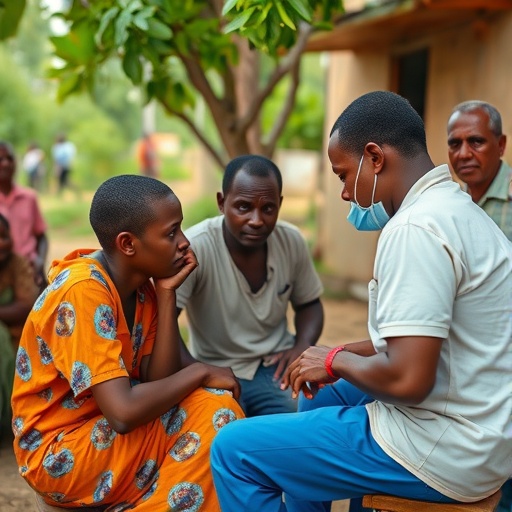In a groundbreaking study published in Nature Communications, researchers have unveiled new insights into the social behavior patterns that critically influence infectious disease transmission in low- and middle-income countries (LMICs). This extensive research effort, carried out between 2021 and 2023 across four diverse LMICs, offers an unprecedented look into how human interactions, daily routines, and mobility collectively shape the dynamics of contagious diseases, presenting vital implications for public health strategies worldwide.
Characterizing social behavior as a key vector of pathogen spread has long posed a challenge due to the intricate and heterogeneous nature of human contact patterns. This multi-country study harnesses sophisticated data collection methods, including high-resolution diaries, sensor-based proximity tracking, and retrospective interviews, to construct detailed interaction matrices. These matrices transcend traditional demographic data to capture not just the frequency, but the context, duration, and physical proximity of contacts across age groups and settings. The research team, led by K.N. Nelson and colleagues, leveraged a multidisciplinary approach integrating epidemiology, social science, and mathematical modeling.
The participating LMICs — each with unique socio-economic and cultural landscapes — provided a rich tapestry for comparative analysis. Urban and rural environments were both considered, highlighting disparities in contact networks prompted by occupation types, household sizes, and social norms. For instance, densely populated urban areas displayed markedly higher contact rates, especially in indoor workplaces and public transportation, whereas rural settings exhibited complex familial and village-centered interactions that extended to broader community clusters.
One of the most compelling findings is the identification of super-spreader potential driven not merely by individual biology but by the structure of social networks themselves. Certain community members act as hubs due to their occupational roles or social behavior, causing transmission chains that conventional contact tracing may overlook. This realization underscores the necessity of intervention strategies tailored to social network topology rather than blanket policies based solely on demographics.
Delving deeper, the study charts the temporal dynamics of social contacts, revealing pivotal fluctuations aligned with cultural events, market days, and school holidays. Such temporal variations impose periodic oscillations in transmission potential, stressing the importance of timing for preventive measures, such as vaccination drives or distribution of personal protective equipment. It also illuminates the peril of ignoring social calendars in pandemic preparedness planning.
From a methodological standpoint, the integration of wearable proximity sensors with participant diaries presents a breakthrough in granularity and accuracy. The sensors captured near-real-time data on physical closeness between individuals, while self-reported diaries supplemented contextual information—ranging from indoor versus outdoor contact environments to mask-wearing practices. This dual data stream allowed for nuanced modeling of contact heterogeneity, a critical determinant of outbreak dynamics often oversimplified in previous models.
Crucially, the researchers quantified the role of children and adolescents in transmission networks, a topic with significant policy implications regarding school closures and vaccination prioritization. The data reveals nuanced age-specific contact patterns, with younger cohorts exhibiting dense peer interaction but limited intergenerational mixing in certain settings, while in others, larger multigenerational households blur these lines. Understanding such distinctions is vital for optimizing resource allocation in outbreak responses.
Moreover, the investigation sheds light on gendered patterns of social interaction, demonstrating that men and women engage in distinctly different contact behaviors shaped by occupational roles and cultural practices. For example, women were more likely to have prolonged household contacts, while men exhibited higher engagement in occupationally driven networks. These disparities impact transmission models and highlight the need for gender-sensitive public health interventions.
An unexpected insight emerged concerning the influence of mobility. The cohort’s movement patterns, embedded within transportation nodes and market interactions, contributed substantially to regional dissemination of infections. The research team mapped these mobility networks using GPS data, revealing corridors of heightened disease risk that transcend administrative boundaries, thereby advocating for cross-jurisdictional coordination in disease control efforts.
Building on these empirical findings, the research has significant ramifications for mathematical modeling of disease spread within LMIC contexts. Models traditionally reliant on simplified contact assumptions can now incorporate detailed contact matrices that reflect real-world heterogeneities. This advancement is expected to refine forecast accuracy, enabling more targeted mitigation strategies that minimize social disruption while maximizing epidemiological impact.
The implications extend beyond infectious diseases to inform behavioral interventions for non-communicable disease risk factors. Understanding social mixing and mobility patterns helps frame contexts for health campaigns, improving uptake and adherence through culturally appropriate messaging and community engagement strategies.
Importantly, the study navigates ethical considerations inherent to social data collection in vulnerable populations. The researchers implemented stringent data privacy and consent protocols, ensuring participant empowerment and transparency. This ethical rigor serves as a benchmark for future socially driven epidemiological research activities.
In sum, this expansive, multidimensional characterization of social behavior relevant to infection transmission signifies a paradigm shift in infectious disease epidemiology, especially for LMICs. By capturing the social fabric in exquisite detail and linking it to disease transmission dynamics, the study equips public health authorities with powerful tools to craft context-sensitive, equitable, and effective disease prevention policies.
As the global community continues to battle emerging and re-emerging pathogens, integrating such social behavior insights into the core of epidemic preparedness and response is no longer optional but essential. The research’s interdisciplinary methodology and its embrace of technological innovations set a new standard for the future of epidemiological investigations, promising a proactive stance in safeguarding global health security.
Subject of Research:
The study investigates social behavior patterns pertinent to infectious disease transmission in four low- and middle-income countries between 2021 and 2023, focusing on contact networks, mobility, and demographic factors shaping epidemiological risk.
Article Title:
Characterizing social behavior relevant for infectious disease transmission in four low- and middle-income countries, 2021-2023.
Article References:
Nelson, K.N., Kiti, M.C., Shiiba, M. et al. Characterizing social behavior relevant for infectious disease transmission in four low- and middle-income countries, 2021-2023. Nat Commun 16, 9586 (2025). https://doi.org/10.1038/s41467-025-64850-9
Image Credits:
AI Generated




